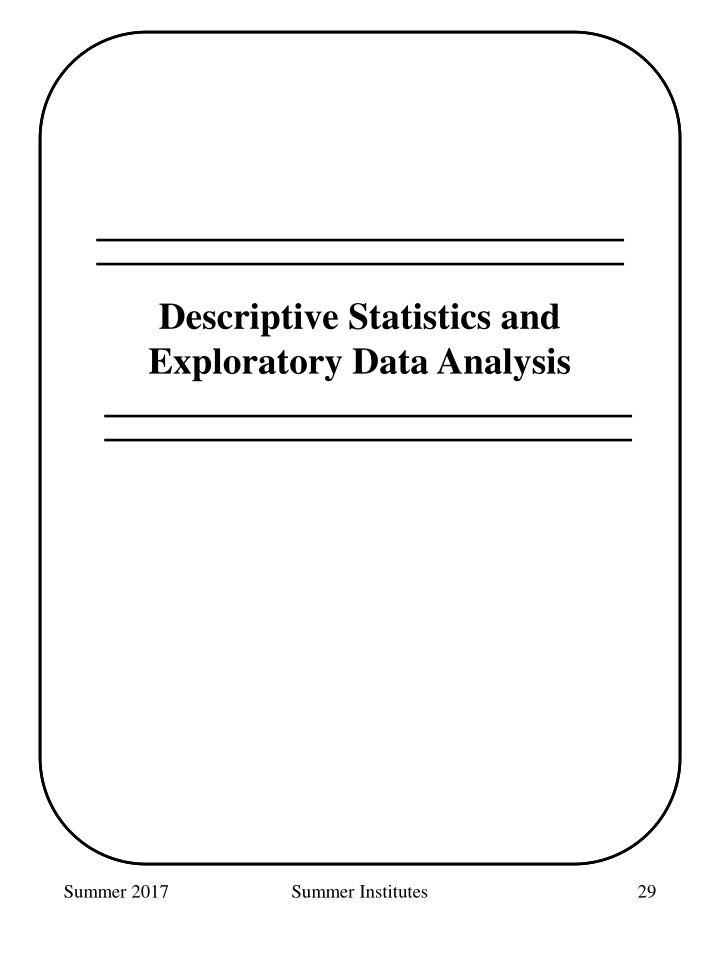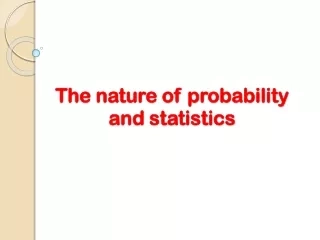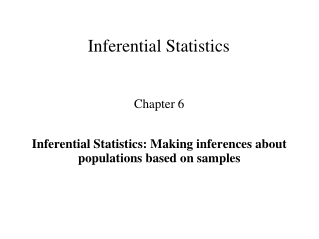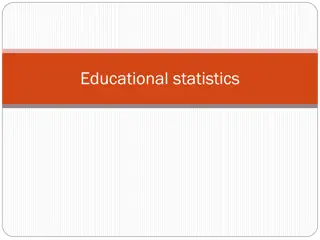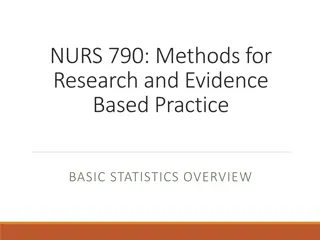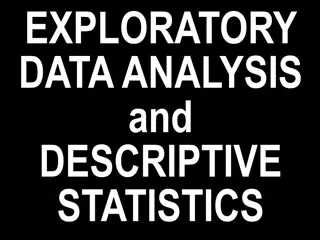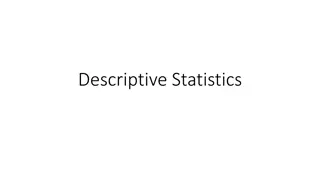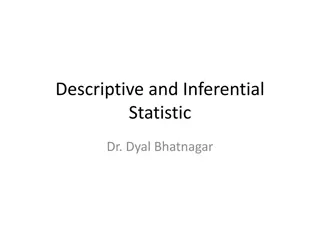Data Analysis: Descriptive, Inferential, and Types of Data
Exploratory/Descriptive statistics along with Inferential/Confirmatory statistics are essential for analyzing and interpreting data. Understanding the types of data, such as categorical and numerical, plays a crucial role in the statistical analysis process. Samples and their organization provide insights into data representation. This content covers the foundation of statistics, from summarization to making predictions, offering a comprehensive guide to statistical analysis techniques.
Download Presentation

Please find below an Image/Link to download the presentation.
The content on the website is provided AS IS for your information and personal use only. It may not be sold, licensed, or shared on other websites without obtaining consent from the author.If you encounter any issues during the download, it is possible that the publisher has removed the file from their server.
You are allowed to download the files provided on this website for personal or commercial use, subject to the condition that they are used lawfully. All files are the property of their respective owners.
The content on the website is provided AS IS for your information and personal use only. It may not be sold, licensed, or shared on other websites without obtaining consent from the author.
E N D
Presentation Transcript
Descriptive Statistics and Exploratory Data Analysis Summer 2017 Summer Institutes 29
Exploratory/Descriptive Statistics Exploratory data analysis can never be the whole story, but nothing else can serve as the foundation stone- the first step John Tukey, founder of EDA school Summarization and presentation of data Generally one of first steps to scientific discovery Definitely one of first steps to scientific understanding If you can t see it, don t believe it! Summer 2017 Summer Institutes 30
Inferential/Confirmatory Statistics Generalization of conclusions: sample population Assess strength of evidence Make comparisons Make predictions Tools: Modeling Estimation and Confidence Intervals Hypothesis Testing Summer 2017 Summer Institutes 31
Exploratory vs Inferential Data Analysis Exploratory (Descriptive) Forming ideas/hypotheses Inferential (Confirmatory) Investigating predefined ideas/hypotheses Historically these approaches have been studied separately, but there is much ongoing modern work in unifying them (2010 present) Summer 2017 Summer Institutes 32
Types of Data Categorical (qualitative) 1) Nominal scale - no natural order - yes/no, nationality, gender 2) Ordinal scale - natural order exists - good/better/best, low/medium/high Numerical (quantitative) 1) Discrete - (few) integer values - number of children in a family 2) Continuous - measure to arbitrary precision - blood pressure, weight Different types of data demand different analysis and graphics tools Think: Categorise zip code Summer 2017 Summer Institutes 33
Samples In statistics we usually deal with a sample of observations or measurements. We will denote a sample of N numerical values as: X1, X2, X3, ,XN where X1 is the first sampled datum, X2 is the second, etc. Sometimes it is useful to order the measurements. We denote the ordered sample as: X(1), X(2), X(3), ,X(N) where X(1) is the smallest value and X(N) is the largest. X1= 60, X2=33, X3=41 X(1)= 33, X(2)=41, X(3)=60 Summer 2017 Summer Institutes 34
Arithmetic Mean The arithmetic mean is the most common measure of the central location of a sample. We use to refer to the mean and define it as: X 1 N = X X = i i N 1 The symbol is shorthand for sum over a specified range. For example: Summer 2017 Summer Institutes 35
Some Properties of the Arithmetic Mean Often we wish to transform variables. Linear changes to variables (i.e. Y = a*X+b) impact the mean in a predictable way: (1) Adding (or subtracting) a constant to all values: = Y + Y X c i i = (2) Multiplication (or division) by a constant: = Y cX i i = Y Does this nice behavior happen for any change? NO! (show that ) log log X X Summer 2017 Summer Institutes 36
Median Another measure of central tendency is the median - the middle one . Half the values are below the median and half are above. Given the ordered sample, X(i), the median is: N odd: = Median N X + 2 1 N even: 1 = + ) Median X X ( ) ( N N +1 2 2 2 Mode The mode is the most frequently occurring value in the sample. Summer 2017 Summer Institutes 37
Comparison of Mean and Median Mean is sensitive to a few very large (or small) values - outliers Median is resistant to outliers Mean is attractive mathematically 50% of sample is above the median, 50% of sample is below the median. Summer 2017 Summer Institutes 38
Variation Much of statistics is concerned with the question relative to what? Variation (also called spread) is how we assess relativity in statistics Summer 2017 Summer Institutes 39
Measures of Spread: Range The range is the difference between the largest and smallest observations: Maximum = Range XN - Minimum = X ( ) ( ) 1 Alternatively, the range may be denoted as the pair of observations: ( ( ) Range = = Minimum,Maximum X XN ) 1, ( ) ( ) The latter form is useful for data quality control. Disadvantage: the sample range increases with increasing sample size. Summer 2017 Summer Institutes 40
Measures of Spread: Variance Consider the following two samples: 20,23,34,26,30,22,40,38,37 30,29,30,31,32,30,28,30,30 These samples have the same mean and median, but the second is much less variable. The average distance from the center is quite small in the second. We use the variance to describe this feature: ( = N X N 1 1 s 1 ) N 2 = 2 s X X i 1 N 1 i 1 i 2 = 2 2 s N X ) i 1 = N i N = 2 2 2 = i ( / X X N i i 1 N = 1 1 The standard deviation is simply the square root of the variance: 2s standard deviation = s = Summer 2017 Summer Institutes 41
For the first sample, we obtain: 30 = = i = X 9 2 i 8574 X 1 ( ) 1 = 2 2 8574 9 30 s 9 1 ( 59 ) = 8574 8100 8 = 2 25 . yr For the second sample, we obtain: = 30 X 9 = 2 i 8110 X = i 1 ( ) 1 = 2 2 8110 9 30 s 9 1 ( ) = 8110 8100 8 = 2 . 1 25 yr Summer 2017 Summer Institutes 42
Properties of the variance/standard deviation Variance and standard deviation are ALWAYS greater than or equal to zero. Linear changes are a little trickier than they were for the mean: (1) Add/substract a constant: Yi=Xi+c 1 Y N = ( ( ) N = 2 = 2 s Y Y i 1 1 i 1 ) N = 2 + + ( ) X c X c i 1 N 1 i = 2 X s (2) Multiply/divide by a constant: Yi=c Xi ( ( 1 1 c N = 1 ) N = 2 = 2 Y s Y Y i 1 N 1 i 1 ) ) N = 2 = cX c X i 1 N i ( N = 2 = 2 X X i 1 s 1 i 2 2 X c So what happens to the standard deviation? Summer 2017 Summer Institutes 43
Measures of Spread: Quantiles and Percentiles The median was the sample value that had 50% of the data below it. More generally, we define the pth percentile as the value which has p% of the sample values less than or equal to it. Quartiles are the (25,50,75) percentiles. The interquartile range is Q.75-Q.25 and is another useful measure of spread. The middle 50% of the data is found between Q.25 and is Q.75. Summer 2017 Summer Institutes 44
Boxplot A graphics display of the quartiles of a dataset, as well as the range. Extremely large or small values are also identified. Increment in Systolic B.P. 40 20 0 -20 1 2 3 4 Drug Summer 2017 Summer Institutes 45
Summary Numerical Summaries 1. location - mean, median, mode. 2. spread - range, variance, standard deviation, IQR Graphical Summaries 1. Boxplot Summer 2017 Summer Institutes 46
Probability Distributions I Summer 2017 Summer Institutes 47
Probability: Why bother? Most of the time we are not interested in the samples that we obtained. We are interested in using the samples to inform a more general understanding. To understand how well our samples generalise to a broader population, we need to know how reliable/representative/variable our samples were. Population Sample Probability dist. Frequency dist. Parameters Estimates Summer 2017 Summer Institutes 48
Probability Distribution Definition: A random variable is a characteristic whose obtained values arise as a result of chance factors. Definition: A probability distribution gives the probability of obtaining all possible (sets of) values of a random variable. It gives the probability of the outcomes of an experiment. Summer 2017 Summer Institutes 49
Theoretical Distributions Used to provide a mathematical description of outcomes of an experiment. A. Discrete variables 1. Binomial - sums of 0/1 outcomes - underlies many epidemiologic applications - basic model for logistic regression 2. Multinomial generalization of binomial - a basic model for log-linear analysis B. Continuous variables 1. Normal - bell-shaped curve; many data summaries are approximately normally distributed. 2. t- distribution 3. Chi-square distribution ( 2) Summer 2017 Summer Institutes 50
Binomial Distribution - Motivation Question: In a family where both parents are carriers for a recessive trait, what is the probability that in a family of 3 children exactly 1 child would be affected? What is the probability that at least 1 would be affected? In a family of 6 children, what is the probability that exactly 1 child is affected? What if the trait is dominant? Summer 2017 Summer Institutes 51
Bernoulli Trial A Bernoulli trial is an experiment with only 2 possible outcomes, which we denote by 0 or 1 (e.g. coin toss) Assumptions: 1) Two possible outcomes - success (1) or failure (0). 2) The probability of success, p, is the same for each trial. 3) The outcome of one trial has no influence on later outcomes (independent trials). Summer 2017 Summer Institutes 52
Binomial Random Variable A binomial random variable is simply the total number of successes in n Bernoulli trials. Example: number of affected children in a family of 3. What we need to know is: 1. How many ways are there to get k successes (k=0, 3) in n trials? 2. What s the probability of any given outcome with exactly k successes (does order matter)? Summer 2017 Summer Institutes 53
Combinations Combinations: number of different arrangements of k objects (successes) taken from a total of n objects (trials) if order doesn t matter. n Cn k = ! n = ( ! k )! k n k n factorial = n! = n (n-1) 1 E.g. Child number 1 + + + - + - - - 2 + + - + - + - - 3 + - + + - - + - Outcomes 3 affected 2 affected 2 affected 2 affected 1 affected 1 affected 1 affected 0 affected Summer 2017 Summer Institutes 54
What are the probabilities of these outcomes? Child number 1 p p p 1-p p 1-p 1-p 1-p 2 p p 1-p p 1-p p 1-p 1-p 3 p 1-p p p 1-p 1-p p 1-p Outcomes 3 affected 2 affected 2 affected 2 affected 1 affected 1 affected 1 affected 0 affected # ways 1 3 3 1 sequence of k + s (0, 1, 2, or 3) and (3-k) s will have probability pk(1-p)3-k 3! But there are such sequences, so in ( ) ! 3 ! k k general Summer 2017 Summer Institutes 55
Binomial Probabilities What is the probability that a binomial random variable with n trials and success probability p will yield exactly k successes? n = = k n k P( 1 ( ) X k) p p k This formula is called the probability mass function for the binomial distribution. Assumptions: 1) Two possible outcomes - success (1) or failure (0) - for each of n trials. 2) The probability of success, p, is the same for each trial. 3) The outcome of one trial has no influence on later outcomes (independent trials). 4) The random variable of interest is the total number of successes. Summer 2017 Summer Institutes 56
n=10, p = .5 .3 .2 Fraction .1 0 0 1 2 3 4 5 6 7 8 9 10 temp n=10, p = .2 .3 .2 Fraction .1 0 0 1 2 3 4 5 6 7 temp Summer 2017 Summer Institutes 57
Binomial Probabilities - Example Returning to the original question: What is the probability of exactly 1 affected child in a family of 3? (recessive trait, carrier parents) Summer 2017 Summer Institutes 58
Mean and Variance of a Discrete Random Variable Given a theoretical probability distribution we can define the mean and variance of a random variable which follows that distribution. These concepts are analogous to the summary measures used for samples except that these now describe the value of these summaries in the limit as the sample size goes to infinity (i.e. the parameters of the population). Suppose a random variable X can take the values {x1,x2, } with probabilities {p1,p2, }. Then MEAN: = = E(X) p jx j j VARIANCE: = = = 2 2 2 V(X) E (X - ) jx ( ) p j j Summer 2017 Summer Institutes 59
Example - Mean and Variance Consider a Bernoulli random variable with success probability p. P[X=1] = p P[X=0]=1-p MEAN: 1 = = [ ] E X p x = j j 0 j = + 1 ( ) 0 1 p p = p VARIANCE 1 = = 2 2 V[ ] ( ) X p x = j j 0 j = 0 ( + 1 ( 2 2 1 ( ) p ) ) p p p p = 1 ( p ) Summer 2017 Summer Institutes 60
Mean and Variance - Binomial Consider a binomial random variable with success probability p and sample size n. X ~ bin(n,p) MEAN: n = = [ ] E X p x = j j j 0 n n = j n j 1 ( ) p p j = j j 0 = ??? VARIANCE: = n = 2 2 V[ ] ( ) X p x = j j j 0 n n = 2 j n j 1 ( ) ( ) p p j = j j 0 = ??? Help! Summer 2017 Summer Institutes 61
Means and Variance of the Sum of independent RV s Recall that a binomial RV is just the sum of n independent Bernoulli random variables. If X1, X2, ,Xn are independent random variables and if we define Y= X1+ X2+ +Xn 1. Means add: E[Y]= E[X1]+E[X2]+ +E[Xn] 2. Variances add: V[Y]= V[X1]+V[X2]+ +V[Xn] We can use these results, together with the properties of the mean and variance that we learned earlier, to obtain the mean and variance of a binomial random variable (Exercise 3). Summer 2017 Summer Institutes 62
Binomial Distribution Summary Binomial 1. Discrete, bounded 2. Parameters - n,p 3. Sum of n independent 0/1 outcomes 4. Sample proportions, logistic regression Summer 2017 Summer Institutes 63
Exercises 1. The current powerball jackpot is $140 million, and your probability of winning it is 1 in 175 million. If it costs $2 to play, what is your expected payoff? 2. A couple intends to have 5 children and both are carriers of myotonic dystrophy, a dominant trait. What is the probability that at least 1 child will have the trait? 3. Calculate the mean and variance of a binomially distributed random variable with n trials and success probability p. Summer 2017 Summer Institutes 64
Ex 1. Solution X = Powerball payoff in dollars There are 2 possible values for X: X= 140000000-2 (which occurs with probability 1/175000000), and X= -2 (occurs with probability 1-1/175000000). EX = (140000000-2)*1/175000000 + -2*(1-1/175000000) = -1.2 So the expected payoff is a loss of $1.20 Summer 2017 Summer Institutes 65
Ex 2. Solution The probability of any single child having the trait is 0.75, and the carrier status of each child is independent of every other. The number of children with the trait (X) is therefore a binomially-distributed random variable with n = 5 and p = 0.75. Summer 2017 Summer Institutes 66
Ex 3. Solution If X ~ Bin(n,p) and Y1, Y2 Yn are independent Bernoulli random variables with success probability p, then X has the same distribution as Y1 + Y2 + + Yn. So Summer 2017 Summer Institutes 67
